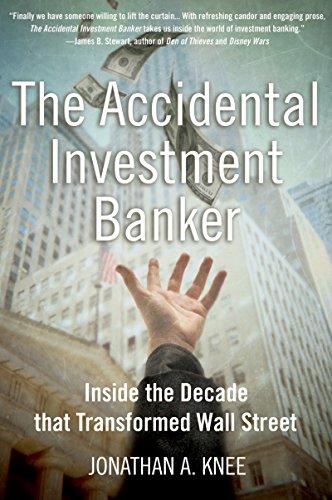The Accidental Investment Banker Summary
5 min read ⌚
 Inside the Decade that Transformed Wall Street
Inside the Decade that Transformed Wall Street
Want to learn more about investment banking?
Interested to find out more about its fabulous past and its speculative present?
Then delve inside the decade that transformed Wall Street – the 1990s.
With Jonathan A. Knee, the “The Accidental Investment Banker.”
Who Should Read “The Accidental Investment Banker”? And Why?
“The New York Times” has described “The Accidental Investment Banker” as “a rare, ringside seat inside the madcap and often egomaniacal world of Wall Street’s Masters of the Universe” adding that for would-be bankers, the book is an excellent primer on what it’s really like; for current bankers it will be a guilty pleasure.
And even if you are neither, we truly believe that you’ll find a lot of enjoyment in peeking behind the curtain and seeing what’s really happening on the fabulous stage of Wall Street.
General readers will marvel, noted “The Wall Street Journal.”
 Jonathan A. Knee
Jonathan A. Knee
Jonathan A. Knee is the Michael T. Fries Professor of Professional Practice of Media and Technology at Columbia Business School and a Senior Advisor at Evercore Partners.
He has earned a BA from Boston University, MSc from Trinity in Dublin, MBA from Stanford and JD from Yale. Before joining Evercore Partners, Knee was a Publishing Sector Head in the Communications, Media and Entertainment Group at Goldman Sachs and, then, a Managing Director and Co-head of Morgan Stanley’s Media Group.
In addition to “The Accidental Investment Banker,” he has authored one more book, “Class Clowns,” and co-authored another, “The Curse of the Mogul.”
“The Accidental Investment Banker PDF Summary”
Before we delve briefly into the quiet beginnings and the wild decades of investment banking, it’s only appropriate to explain what an investment bank actually is.
By strict definition, an investment bank is usually a private company which provides various financial (and finance-related) services to individuals, corporations, and even governments.
Mostly these all boil down to two primary functions: corporate finance and sales and trading.
Corporate finance is what investment banks traditionally do (and have done for centuries).
In a nutshell, it means helping customers raise funds (via mutual funds, pension funds, etc.) so that they can develop new capabilities or purchase new assets.
In the latter case – i.e., mergers and acquisitions (M&A) – investment banks can also give advisory services to companies on how to best consolidate the new assets under one entity.
In its sales and trading function, an investment bank basically serves as the middleman, buying and selling securities on behalf of itself and its clients, earning some percent of the funds it raises.
On IPOs, for example, an investment bank’s “spread” can be up to 7% of the raised finances!
Now, even though investment banking began with the activities of the Dutch East India Company a few centuries ago, it actually became something big in the United States in the early 20th century.
More or less just as today, the leading investment banking houses at the time were Morgan Stanley and Goldman Sachs, closely followed by Merrill Lynch.
Behind them, four investment banks which, for one reason or another, don’t exist anymore: First Boston, Lehman Brothers, Donaldson, Lufkin & Jenrette (DLJ), and Salomon Brothers.
After the Great Depression of 1929, investment banks entered a golden era.
How could they not?
In a world practically bereaved of financial euphoria, the investment banks of the time were all but the only model financial institutions, so everybody respected them as such.
Loyal to their customers and as conservative as possible, the investment banks of this period prized integrity above all and didn’t want to blow their own horns that much:
With roots going back over a century, the major investment banking houses largely eschewed publicity and had developed their own idiosyncratic cultures built on notions of exclusivity, integrity and conservatism.
And if there is one man who embodies golden-era investment banking, then that man is certainly Goldman Sachs’ long-time leader, Sidney Weinberg, Mr. Wall Street himself.
Widely respected, Weinberg was both a shrewd and an honest man, with a keen eye for business, but also with the integrity to stay away from speculative businesses; for example, he refused to underwrite gambling-related businesses.
However, soon after Weinberg’s death in 1969, views such as these became not only outdated but also a competitive disadvantage.
And the relatively humble white-shoe conservative investment banker of the war years morphed into the unorthodox M&A rock star with a lavish lifestyle and a six-figure paycheck.
J.P. Morgan Jr. may have advised doing “first-class business in a first-class way,” but the Wall Street motto of the 1990s spelled anything but: “IBG-YBG” (i.e., “I’ll be gone, you’ll be gone.”) meant that “short-term thinking,” was now the only valid way to run an investment bank.
And, as usual, short-term thinking resulted in a disaster in the long run.
Investment banks did rebound a few years after the crash of 2000 rattled the industry, but, expectedly, they never regained their reputation of the golden-era Weinberg years.
Key Lessons from “The Accidental Investment Banker”
1. The Two Primary Functions of Investment Banks
2. The Golden Era of Investment Banking
3. The Boom and the Bust of the 1990s
The Two Primary Functions of Investment Banks
Investment banks have two primary functions: corporate finance and sales and trading.
The corporate finance function includes raising funds for their clients, be they individuals, corporations, or governments. It also incorporates giving valuable advice concerning mergers and acquisitions (M&A).
The sales and trading function means underwriting the clients’ assets, i.e., buying and selling securities, and earning a percentage of it.
The Golden Era of Investment Banking
After the Great Depression, investment banks were conservative institutions, mostly interested in long-term plans and staying away from speculations.
Sidney Weinberg – Goldman Sachs’ CEO from 1930 to his death in 1969 – typified the era: an honest and reliable man, he stayed away from hostile takeover bids and refused to underwrite gambling businesses.
Most investment banks followed suit, making them the most reliable financial institutions of the war (Second World War, Cold War) years.
The Boom and the Bust of the 1990s
However, the 1980s infamously turned Wall Street into a den of thieves, and during the 1990s things really spiraled out of control.
First – for the better; and then – for the worse:
Just as the investment banks were ill-prepared to deal with the boom of the 1990s, they had no road map to manage the bust of the new millennium.
Unsurprisingly, investment banks haven’t recovered their golden-era reputation of trusted, loyal advisers.
In fact, nowadays, there’s “an unprecedented level of cynicism, suspicion, and distrust of investment banks” among CEOs.
Probably for a very good reason.
Like this summary? We’d like to invite you to download our free 12 min app, for more amazing summaries and audiobooks.
“The Accidental Investment Banker Quotes”
What sends an investment banking firm into decline is typically a major scandal, a capital crisis, a mass exodus of productive partners, or usually some combination of the three. Share on X
Investment banks and investment bankers had always thought of themselves as providing a highly differentiated value-added service – strategic advice selected based on quality. Share on X
Investment banking, at bottom, is a sales job. Share on X
The ‘spin’ involved in any sales job has a comic aspect that takes on an even more absurd quality when the financial stakes are as high as in investment banking. Share on X
Our Critical Review
“The Accidental Investment Banker” is, by all accounts, a rare book: an insider’s look into the world of investment banking.
Written by someone who has worked at both Goldman Sachs and Morgan Stanley, the book chronicles the madness of the boom and the bust of the 1990s with appropriate flair and panache and abounds with engaging intrigues and memorable anecdotes.
To quote “Fortune” magazine, “For anyone who remembers the crazy boom times, and the even crazier bust, Jonathan A. Knee’s ‘The Accidental Investment Banker’ is a must.”
Emir is the Head of Marketing at 12min. In his spare time, he loves to meditate and play soccer.


 Inside the Decade that Transformed Wall Street
Inside the Decade that Transformed Wall Street Jonathan A. Knee
Jonathan A. Knee




